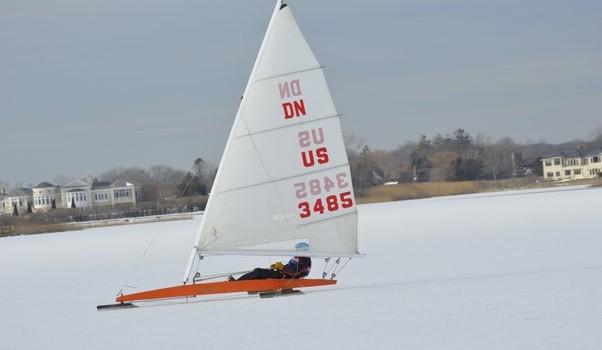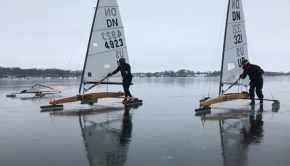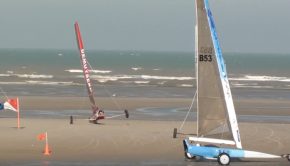Ice Boating: A Water Mill Tradition Lives On
Published on February 8th, 2014
(February 7, 2014) – Everything that comes with ice boating, from the initial rush one gets when the sails fill with wind to the sport’s enduring appeal, boils down to human nature, according to local enthusiast and ice boat historian Tom Halsey.
“The second someone gets something that goes fast, someone else gets something that goes fast, and they race,” Mr. Halsey, who retired competitively from the sport two years ago, said on Tuesday. “Ice boating is fun, but it’s the competition that keeps you going.”
Unfortunately for those of his ilk, competition on the East End has waned in recent years, with bays and ponds refusing to freeze over in winter. In fact, until last week, when a contingent could be seen racing from one end to the other, boats haven’t hit Mecox Bay ice since 2011.
Ice boating on Mecox began back in 1836, Mr. Halsey said, when young men Daniel Hildreth and Charles Howell built their very own boat and sailed across the bay.
“She works like a charm,” Mr. Hildreth wrote in his diary. “She went a mile a minute.”
After that, there is no further evidence of the sport’s local roots until 1878, when a photograph dated that year shows Lemuel Halsey, the great-great-grandfather of Tom, sailing with his friend and hired captain, Jeter Rose.
“Man, those old-time boats were totally different creatures,” Tom Halsey said, admiring the hulking three-sail boat in the black and white picture. It was a sport for a select few who could afford both the equipment and the time spent sailing.
“My dad used to tell me stories about these huge ice boats, owned by the Vanderbilts and whatnot, racing trains down the Hudson and gambling on who would win,” said fellow local racer Chip Maran, sort of a protege of Tom’s brother John Halsey, from the ice on Friday.
But around the turn of last century, Mr. Halsey said, “everyone began getting into the act.”
With about 15 different boats forming the Ice Boat Club of Water Mill, the sport took off locally, and what was once a fun activity during the dead of a frigid winter became a competitive addiction for some.
“There were always people who were there for the peripheral things—the girls, the fun, the speed,” Mr. Halsey said. “Then there were those who just wanted to race and win. My father just wanted to race. I’m my father’s son. Me, I’ve wanted to do nothing but race since the day I was put in a boat.”
And once Mr. Halsey’s father, Everett, got the competitive bug, the club began sailing in mile-long regattas up and down the Northeast Corridor against teams and boats from around the world.
“It is a very physical and a very serious sport,” Mr. Halsey said. “When it gets to that level of sailing, there is no fooling around about it. You’re there to win.”
Then the boats began to change, and the sport along with them.
Once dominated by what were essentially boats on skates, the sport was now being taken over by Detroit News Boats. Otherwise known as DN boats, these more compact, more easily transported vessels were more like aerodynamic automobile hulls with two runners and a sail.
Around 1950, the old ice boating club became the Mecox Bay Ice Yacht Club, which began hosting DN tournaments of its own on Mecox Bay—one was even covered by Sports Illustrated.
Ed “Rock” Hildreth, Mr. Halsey’s best friend, bought a DN boat years later and began teasing him about a race.
“We were just ferocious competitors, between each other and everyone else too,” Mr. Halsey laughed. “One day, he said, ‘I hear there’s a trophy in Ronkonkoma for ice boating. We’ve got to get it.’”
The two placed third and fourth the very next year in the Long Island Championship, one of the sport’s most prestigious competitions, and both eventually took home the trophy, numerous times.
But while winning was the goal, racing was about more than a trophy and a title.
Mr. Halsey talks fondly of the camaraderie and the relationships built all over the island.
The club traveled in a pack with “the father of DN ice boating,” nine-time winner of the Long Island championship Reuben Snodgrass.
They would travel with their families, call one another about new tournaments and relentlessly go out and drill the ice, seeing if it was thick enough to race on.
But the heyday of the sport has past, Mr. Halsey admitted.
Thanks to a confluence of reasons, the sport “I wouldn’t say is dying but is diminishing over the past 10 or 15 years,” he said. “And it isn’t necessarily ice boating that is dying, but the DN class and the competitions are dying, because the uncertainty of the ice isn’t something that most top competitors have patience for.
“The enthusiasm for the sport on the East End has never waned,” he continued. “The number of people who do it out here is directly proportional to how good the ice is, though.”
Two years ago, with his ties to the originators of the sport’s Long Island scene fading, Mr. Halsey won the Long Island Championship for the last time—and promptly retired at the top.
“I go through these books of Long Island ice boating history, and half the people I see are dead and gone,” he said somberly. “The sport needs new blood if it is going to thrive again.”
New blood or not, Mr. Halsey thinks a couple of good days of ice would bring a fleet of about 25 ice boats out to Mecox, ready to race like in the old days.
This past Sunday, the seventh generation of Halseys hit the ice, spiked shoes all laced up and snowboard goggles snug to their faces. If all goes as planned, according to Mr. Halsey, it won’t be long until they too get the bug and their own boats, and then let human nature take over. Story









 We’ll keep your information safe.
We’ll keep your information safe.